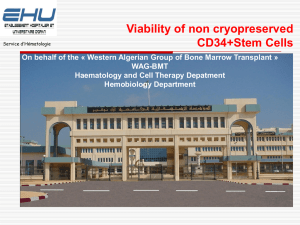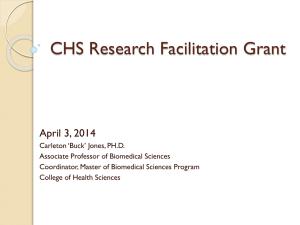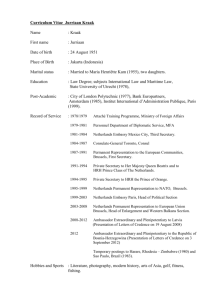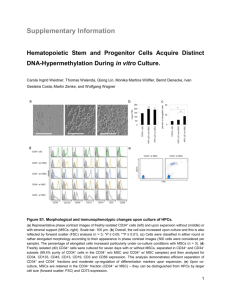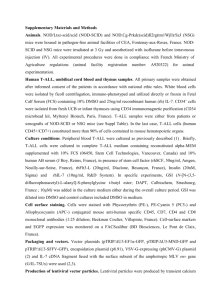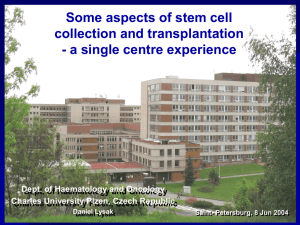Materials and methods – Woolthuis et al
advertisement
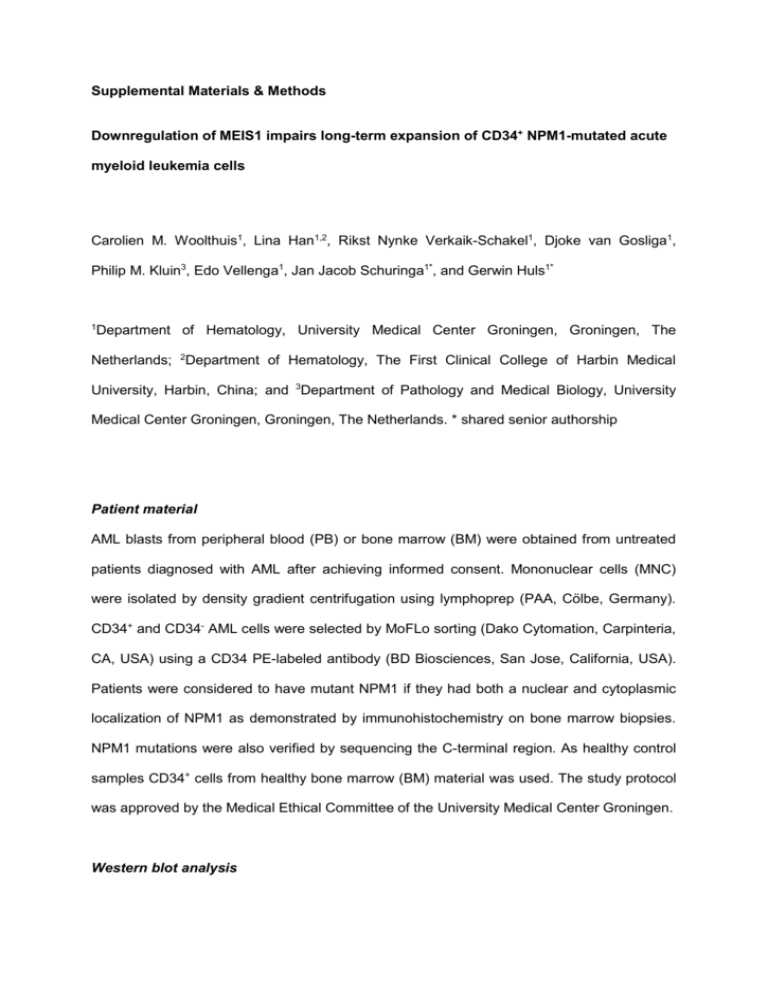
Supplemental Materials & Methods Downregulation of MEIS1 impairs long-term expansion of CD34+ NPM1-mutated acute myeloid leukemia cells Carolien M. Woolthuis1, Lina Han1,2, Rikst Nynke Verkaik-Schakel1, Djoke van Gosliga1, Philip M. Kluin3, Edo Vellenga1, Jan Jacob Schuringa1*, and Gerwin Huls1* 1 Department of Hematology, University Medical Center Groningen, Groningen, The Netherlands; 2Department of Hematology, The First Clinical College of Harbin Medical University, Harbin, China; and 3Department of Pathology and Medical Biology, University Medical Center Groningen, Groningen, The Netherlands. * shared senior authorship Patient material AML blasts from peripheral blood (PB) or bone marrow (BM) were obtained from untreated patients diagnosed with AML after achieving informed consent. Mononuclear cells (MNC) were isolated by density gradient centrifugation using lymphoprep (PAA, Cölbe, Germany). CD34+ and CD34- AML cells were selected by MoFLo sorting (Dako Cytomation, Carpinteria, CA, USA) using a CD34 PE-labeled antibody (BD Biosciences, San Jose, California, USA). Patients were considered to have mutant NPM1 if they had both a nuclear and cytoplasmic localization of NPM1 as demonstrated by immunohistochemistry on bone marrow biopsies. NPM1 mutations were also verified by sequencing the C-terminal region. As healthy control samples CD34+ cells from healthy bone marrow (BM) material was used. The study protocol was approved by the Medical Ethical Committee of the University Medical Center Groningen. Western blot analysis Western blot analysis was performed using standard procedures. The rabbit polyclonal antibody (SIL-A) specifically recognizing the NPM1 mutant A protein (kindly provided by Prof. Falini, Institute of Hematology, University of Perugia, Perugia, Italy) was used in a concentration of 1:250 and incubated overnight at 4ºC after blocking with 5% BSA in TBSTween (0.05%) for one hour. The mouse monoclonal antibody recognizing both wild type and mutant NPM1 (also a generous gift of Prof. Falini, University of Perugia) was used in a concentration of 1:300 and incubated for 2-3 hours at room temperature. The antibody against MEIS (clone 9.2.7) was obtained from Millipore (Amsterdam, The Netherlands). The β-actin antibody was obtained from Santa Cruz Biotechnology (Heidelberg, Germany). Secondary antibodies were obtained from DAKO (Glostrup, Denmark) and used in a concentration of 1:3000. The K562 cell line was used as a negative control and the OCIAML3 cell line as a positive control for mutant NPM1. Sequencing analysis Total RNA was isolated using the RNeasy kit from Qiagen (Venlo, The Netherlands) according to the manufacturer’s recommendations. For NPM1 mutation analysis RT-PCR was performed using the forward primer 5′-agcgccagtgaagaaatc-3′ and the reverse primer 5′cacggtagggaaagttctc-3′. PCR products were sequenced to identify the mutation. Long-term AML cultures on MS5 stroma Long-term AML cultures were performed as described previously (van Gosliga et al. Exp Hematol 2007). Briefly, for the long-term cultures 6 to 40 x 103 cells, sorted based on CD34 expression, were plated in a 12-wells plate precoated with MS5 stromal cells. Cells were expanded in LTC medium (α-minimum essential medium supplemented with heat-inactivated 12.5% fetal calf serum (Sigma, Zwijndrecht, The Netherlands), heat-inactivated 12.5% horse serum (Sigma), penicillin and streptomycin, 2 mM glutamine, 57.2 µM β-mercaptoethanol (Sigma) and 1 µM hydrocortisone (Sigma) supplemented with 20 ng/ml IL-3, 20 ng/ml granulocyte colony-stimulating factor (G-CSF) (Rhone-Poulenc Rorer, Amstelveen, The Netherlands) and 20 ng/ml thrombopoietin (TPO) (Kirin, Tokyo, Japan). Cultures were kept at 37 ºC and 5% CO2. Cultures were demi-depopulated weekly for analysis. After five weeks both suspension and trypsinized cobblestone area forming cells (CAFC) were harvested to initiate second co-cultures on a new stromal layer. Before replating CAFC were separated from old MS5 cells by MoFLo sorting based on human CD45 and/or CD34 expression. Both suspension and sorted CAFC cells were used in the replating experiments. Pictures of stromal co-cultures were taken using a Leica DM-IL microscope (Leica Microsystems, Rijswijk, The Netherlands) with a 40x/0.60 objective. Lentiviral transductions The lentivirus short hairpin RNA vector targeting both human as well as murine MEIS1 was obtained from Open Biosystems (Huntsville, AL; Accessionnumber: NM_002398; source ID: TRCN0000012526) and cloned into the pLKO.1 lentiviral vector containing green fluorescent protein (GFP). A control vector was made by cloning a scrambled (SCR) short hairpin into the pLKO.1 GFP vector. Lentiviral particles were made by transient transfection of 293T cells with the lentiviral expression vectors and stable transduction of CD34+ AML cells was performed, both were extensively described previously (Schepers et al. Blood 2007). Gene expression profiling AML MNC fractions derived from PB or BM were sorted based on CD34 expression on a MoFlo. Total RNA was isolated using the RNeasy mini kit from Qiagen (Venlo, The Netherlands) according to the manufacturer’s recommendations. RNA quality was examined using the Agilent 2100 Bioanalyzer (Agilent Technologies, Waldbronn, Germany). For realtime RT-PCR, cDNA was prepared and amplified using iQ SYBR Green supermix (Bio-Rad, Veenendaal, The Netherlands) in a MyIQ thermocycler (Bio-Rad), and quantified using MyIQ software (Bio-Rad) using RPL27 and HPRT as housekeeping genes. Genome-wide expression analysis was performed on Illumina (Illumina, Inc., San Diego, CA) BeadChip Arrays Sentrix Human-6 (46k probesets). Typically, 0.5-1 µg of mRNA was used in labeling reactions and hybridization with the arrays according to the manufacturer’s instructions. Data were analyzed using the BeadStudio v3 Gene Expression Module (Illumina, Inc.) and Genespring (Agilent, Amstelveen, The Netherlands). Statistical analysis Clustering analyses were performed on the basis of gene expression profiles using Genespring GX10 software. For comparison of CD34+ NPMc+ versus NPMwt AML and NBM samples a random variance t-test was used. For this experiment differential expression was considered significant at P<1E10-6. For comparison of CD34+ and CD34- an unpaired twosided t-test was used with equal variance and P<0.001.




